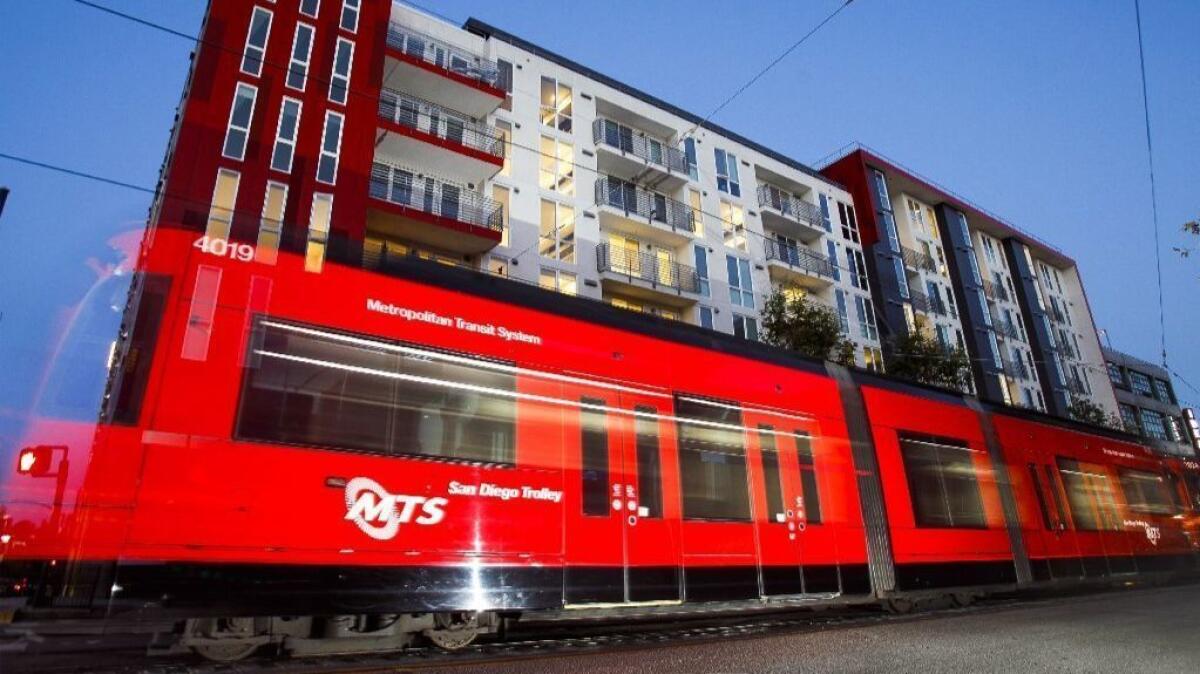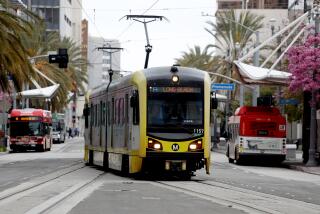San Diegans could face two tax hikes to fund world-class transit system. But will they foot the bill?

- Share via
Reporting from San Diego — San Diegans will probably be asked in coming years to pay for a costly, yet world-class public transit system — complete with a San Diego Grand Central, new rail lines and commute times that rival driving.
To fund the ambitious vision, officials are gearing up to ask the region’s historically tax-averse electorate to approve not one but two new tax hikes, the first of which could be before voters as soon as November 2020.
For months, leaders at the county’s premiere transportation and planning agency, the San Diego Assn. of Governments, have sketched out the need for tens of billions of dollars in public funding to overhaul the region’s transit system.
Now officials with the San Diego Metropolitan Transit System say they’re also serious about pursuing a tax increase to pay for bus and rail upgrades.
Political and transportation experts have said the move could be risky, potentially confusing voters and stretching thin their patience for new taxes.
“There’s only so many sales-tax measures that voters are going to support,” said Ethan Elkind, a transportation and land-use researcher at UC Berkeley’s Center for Law, Energy and the Environment. “I think that’s a legitimate concern if you have these dueling measures. It’s going to be hard to go back to voters for a second bite at the apple.”
Still, if voters believe that officials can deliver a transit system worth riding, they could be convinced to fork over the money, said Thad Kousser, chair of the political science department of UC San Diego.
“What voters care about is the value proposition,” he said. “If you can sell them on this being a good investment, it doesn’t matter how big that investment is.
“It’s making people who don’t think of themselves as transit riders now, envision themselves as riding,” he added.
Asking voters to approve multiple ballot measures, each requiring the onerous two-thirds approval, does not appear to be a coordinated tactic among the two transportation agencies.
MTS board Chair Georgette Gómez announced last week the organization’s strong interest in placing a half-cent sales tax increase before voters in the upcoming presidential election.
Gómez — who also sits on the SANDAG board — dismissed the idea that a second measure was even on the table.
“At the moment, I don’t know that SANDAG has been exploring a measure, but I do know that MTS is,” she said. “I, we, are working very closely with SANDAG. If they are to explore a measure … I don’t think this is competing to that, but that’s if they ever go back to the ballot, to the voters, in the future.”
But over the last three months, SANDAG’s recently hired top official, Hasan Ikhrata, has been leading the charge to radically modernize the region’s transit system — making no bones about his intent to go to the voters for public funding.
“It’s going to need more than half a cent of sales tax,” he recently said in an interview. “It’s going to be expensive.”
Ikhrata, who’s rumored to be privately concerned about putting two measures before voters, has publicly expressed support for MTS’s efforts to raise money.
“I hope they’re successful, and I’m going to support and coordinate with them,” he said. “If this is a down payment that’s OK.”
Ikhrata — a widely lauded transportation expert who left his position as the head of the Southern California Assn. of Governments in December to lead SANDAG — has repeatedly said his goal is to develop a public transit system that’s at least as fast as driving.
His ambition has seemingly emboldened other transportation officials.
“If you really want to make transit work better, there’s really two key ingredients, make it goes faster, make it go more frequently,” MTS CEO Paul Jablonski said at a recent event.
To make transit competitive with driving, Ikhrata has floated everything from exploring a futuristic hyperloop system to constructing an underground trolley line from San Ysidro to Kearny Mesa to building a “Grand Central” station that would connect regional transit riders to the San Diego International Airport.
All this is necessary, he’s argued, not only to boost the economy and draw new talent to the area but to meet state mandates for limiting greenhouse gases from cars and trucks.
His ideas have been everything the region’s environmental and transit advocates have been yearning to hear for decades.
“I will credit Hasan in being relentless in his public outreach in conveying a big vision,” said Nicole Capretz, executive director of the San Diego-based Climate Action Campaign.
One of those public transit advocates has been Gómez, who before being elected to the City Council in 2016 worked for more than a decade with the Environmental Health Coalition, representing low-income neighborhoods of color suffering from toxic air pollution.
SANDAG is expected to release an initial blueprint for modernizing the region’s transportation system by the end of the year.
At the same time, Gómez said MTS will be embarking on a months-long public outreach campaign to better understand what projects voters desire and would be inclined to fund.
“We’re going to be very intentional on how we’re going to be gathering information and very transparent,” she said. “We’re going to be inclusive, transparent and we are going to be making sure that we are held accountable to our riders.”
Her comments come less than two years after SANDAG’s previous executive director, Gary Gallegos, resigned amid scandal. After a 2016 tax increase put forth by the agency failed at the ballot, it was revealed that Gallegos had promised voters a long list of highway and transit projects the half-cent levy probably wouldn’t have covered.
Both agencies would like to distance themselves from SANDAG’s former incarnation, which had made enemies on all sides of the political spectrum.
While MTS has a relatively clean record, its efforts to raise money for an all-transit ballot measure will probably be an uphill battle. Most successful transportation tax measures include a wide variety of projects, from rail and bus expansions to highway and road improvements.
Voters serviced by L.A. County’s Metropolitan Transportation Authority have approved four half-cent sales tax measures since 1980, all of which included some funding for highway infrastructure.
“Transit-only measures face a much more demanding hurdle than measures that include things for multiple interest groups,” said Martin Wachs, a distinguished professor emeritus at UCLA’s Department of Urban Planning, who has studied transportation systems and policies around the world.
Wachs also said that putting two tax increases before voters could jeopardize the success of both.
“It’s pretty clear that voters need to have a relatively straight forward understanding of what is happening, and they will vote ‘no’ if they don’t understand what the measure is or they think another measure is coming soon,” he said. “So a single measure will stand a much greater chance of passage.”
MTS officials said this week that recent polling found 67% of voters would “definitely” or “probably” vote for a half-cent sales tax to fund an expansion of the existing transit network. The agency wouldn’t release the full survey results, citing an exemption under the California Public Records Act.
Such a razor-thin margin raises questions about to what extent organized groups will attempt to kill the tax increase.
“Yeah, there will be funded opposition,” said Tony Krvaric, chairman of the Republican Party of San Diego County. “I think people’s appetite for taxes is over. We just had a gas tax. It’s completely absurd.”
Haney Hong, president and CEO of the San Diego Taxpayer Assn., struck a more measured tone.
“Expanding public transit in our region is important, but the devil’s in the details. We look forward to seeing what MTS puts together for a ballot measure and then giving it a good scrub to see if it uses taxpayer dollars well, and is able to deliver what it promises.”
The first measure to the ballot has the best chances of passing, but that does mean it will raise enough money to truly overhaul the transit system, said Carl Luna, a political science professor at San Diego Mesa College.
“It would be nice and smart and more effective if SANDAG and MTS would have come together to develop a unified, complementary plan,” Luna said.
“Summer’s coming,” he added. “Maybe we can lock the leadership in a room, turn off the air conditioning and keep them in there until they come up with a comprehensive regional transportation plan. I’ll pop for a round of iced lattes to reward them all if they reached a deal.”
Smith writes for the San Diego Union-Tribune.
More to Read
Sign up for Essential California
The most important California stories and recommendations in your inbox every morning.
You may occasionally receive promotional content from the Los Angeles Times.














